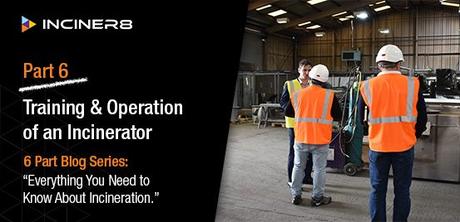
Why is it important to be trained to correctly operate an incinerator?
The incinerator is a very specialised piece of equipment which needs to be operated and maintained by suitably qualified and experienced personell (SQEP's). The incinerator equipment operates at very high temperatures and pressures with many heavy duty moving mechanical, hydraulic parts and very high voltage electrical supply.
In addition to this there are flammable liquids and gas fuel supplies in the system and in some cases, compressed gas systems as well as the actual incinerator waste fuel itself. The safe operation of the incinerator plant and its associated ancillaries are designed to be inherently safe is to be and system.
All operation, maintenance and repairs must be carried out by SQEP for safe operation and longevity of the incinerator system. All personal involved in the safe operation and maintenance of the machine have to be adequately trained and certified before being allowed to operate or maintain the equipment.
Theory Training
This initial training should be undertaken by all staff cover the following information and be signed off from the supervisors or plant operator once the candidate has achieved a recognised standard of understanding which needs to be examined.
Subjects covered should include;
- Health and safety
- COSHH (Control of Substances Hazardous to Health)
- Understanding incinerator legislation
- Personal Protective Equipment (PPE)
- Fundamentals of combustion
- What is fuel?
- Fuel burn rates and how they are optimised
- Emissions and how to control them
- Waste fuels which can/can't be incinerated
- Main component parts of the incinerator system and their function, i.e, control panel, secondary chamber, ducting, heat exchanger, pollution control system, Organic Rankine Cycle generator and ID/FD fans.
Practical Training
This second phase of the training should be based on the physical familiarisation of the machine and its component parts. A walk around inspection should include training on the following:
- Health and safety
- Issue of PPE kits
- Isolation of system (electrical, fuel, waste etc.)
- Emergency shutdown procedures
- Buddying system for inspection of chambers, mechanical moving parts etc.
- Checks for leaks, electrical connection, pneumatic and hydraulic lines etc.
- Check condition of all doors, hatches and openings and ensure there are no personnel inside the chambers or any other object which is likely to cause injury, damage, or death.
- Ensure all hatches, doors and openings are fully closed and secures.
- Inspect the incinerator on a systematic and methodical manner - starting at the front and working around the whole system using the checklist.
- Sign inspection paperwork an countersign from supervisor before starting up procedure can begin.
Start-up Procedures
The third phase of training is set around ensuring that the staff and operators are familiar with the process of starting the machine and bring it up to operating condition in a safe and systematic manner. The subjects covered in this phase of training should include:
- Health and safety
- Use of PPE
- Control panel familiarisation
- Cold start procedures
- Attaining and maintaining temperatures
- Introduction of waste fuel
- Monitoring of temperatures in the primary and secondary chambers
- Monitoring oxygen concentration, fan speeds and waste fuel burn
- Emergency procedures during start up
Standard Operating Procedures
The fourth phase of training is to ensure that operators fully understand the parameters of normal operations. The subjects should include:
- Health and safety
- Understanding the temperature settings
- Understanding the waste burn rates
- Understanding the setting of fans and blowers
- Monitoring procedures during operation
- Determining the balance for efficient combustion
- Maintenance during operation
- Ash removal during operation
- Emergency procedures during normal operation
Shut Down Procedures
The fifth phase of training is understanding the process of safely shutting the incinerator system in a controlled and systematic manner. The subjects covered should include:
- The importance of staged cooling of the incinerator
- Sequence of shutdown i.e. stop waste fuel, reduce burners (if applicable), and modulate airflow
- Allow drop of temperature in chambers to reduce in staged manner
- Visual inspection of system during shut down.
Maintenance Procedures
The sixth phase is to ensure that the machine is maintained to the standards for normal and safe operation. The subjects covered should be as follows:
- Health and safety
- Risk assessment and method statement
- Personal Protective Equipment
- Buddy system agreed
- COSHH
- Spare parts inventory
- Tools and specialist equipment for maintenance
- Isolation of incinerator system
- Repairs, replacements, and adjustments
- Reports and photographic evidence
- Check all mechanical systems
- Check all electrical systems
- Check all pneumatic/hydraulic systems
- Paperwork and supervisor sign off for completed work
Paperwork and Maintenance Record Procedures
All staff involved in the operation of the incinerator system must maintain records of operation and be adequately trained to ensure that the records are completed in a manner which is audit-able and in compliance with the warranty requirements.
- Copies of training and competence certificate for all staff involved with the operation of the incinerator
- Weekly, monthly, quarterly, and annual reports and filing system
- Audit and update the spare parts inventory
- Review of minor, major and critical failures
- Warranty documents and OEM handbook
To find out what incinerator training programme we can deliver for you and your team, speak to one of our experts today. We have training courses available in the UK, Canada, UAE, and Croatia.
This blog is the final part to our 6 part series on "Everything You Need to Know About Incineration", brought to you by our expert technical team at INCINER8
Click the links below to read:
